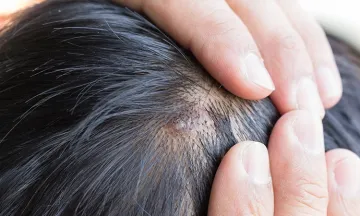Endometriosis: Early Detection and Prevention
Endometriosis is a condition in which the uterine lining develops not just inside (which is natural) but also outside the uterus. The tissues that form the outside lining undergo the same process of forming up and breaking down, just like the inside lining during menstruation. Some regular symptoms are heavy period discharge, abdominal pain and infertility.
What is endometriosis?
Endometriosis is a chronic recurring condition that affects a woman’s reproductive organs. It happens when the lining cells (the endometrium) of the uterus grow outside of it. Often it is found on, and around, the pelvic and abdominal organs, including the ovaries. About 10% of women (around 176 million worldwide) are affected.
What happens?
The endometrial tissue cells may:
- stick to organs in the pelvis
- start to grow and form plaques or patches on the outside of pelvic tissues, particularly the peritoneum (inside of the abdomen and pelvis) and nodules that invade organs such as ovaries and ligaments
- have the same cyclical/menstrual changes inside and outside the uterus
- bleed at the same time as your menstrual period
What causes endometriosis?
We don’t really know what causes endometriosis, and possible causes can vary, but may include:
- a family history of endometriosis, i.e. a close relative with the condition
- retrograde (backwards) menstruation; during a period, menstrual blood flows out of the vagina, but also backwards along the fallopian tubes
- the growth of endometrial tissue. In most women, the blood containing this tissue gets absorbed or broken down and causes no symptoms. In women with endometriosis, this tissue starts to grow
- type of period: heavy bleeding, lasting longer than five days; first period before 11 years of age; regularly less than 27 days between periods
- low body weight
What are the signs and symptoms?
The symptoms vary from woman to woman. Some have many symptoms where severe pain occurs, others have no symptoms.
-
Pain:
Pain is one of the biggest symptoms. This can be pain immediately before and during your period and/or during or after sex. Pain can be felt in the tummy, back, pelvis, with a bowel movement, passing wind or urine, or when you ovulate.
-
Heavy bleeding:
Heavy bleeding can occur with or without clots. Bleeding may be irregular, continue for a long time or you may have spotting before your menstrual period.
-
Bladder and bowel problems:
Bladder and bowel problems may occur, e.g. constipation or diarrhoea, feeling the need to urinate more frequently at different times in your menstrual period, and bloating.
What can you do?
If you think you have endometriosis, see your doctor at the earliest. Don’t delay as early diagnosis and treatment may reduce the severity of the disease. Many women do not get a correct diagnosis for up to 7-10 years, often because the symptoms can be different between women and can change over time.
The right treatment will depend on your symptoms, the severity of the condition and whether you are trying to become pregnant or maintain your ability to have children. Homeopathy treatment is suggested for all the female sexual health related diseases as it is a time-tested medical science. Homeopathic remedies are in use for more than two hundred years and are still are in use with the same efficacy. Unlike allopathic medicines, homeopathy has no side-effects. The primary aim of Homeopathic medicines for endometriosis is to provide symptomatic relief to a patient. In the process, they also treat related issues, majorly infertility arising from inflammation, adhesions and scarring within fallopian tubes.
Managing and treating endometriosis
There is no direct evidence that lifestyle affects endometriosis, however, it is important to remain as healthy as possible. To function optimally, the body needs a diet that focuses on increasing the intake of nutrients and reducing the burden on the body. We are aware that most illnesses respond positively to a healthy balanced diet and Endometriosis is no exception. Endometriosis can be triggered by a combination of factors including hormonal imbalances (oestrogen dominance), stress and nutritional deficiencies. Hence, a multi-factorial approach is the best way to tackle it. Outlined below are a few steps that will ensure that your body gets all the right nutrients to enable it to fight its own battles.
- Follow a rainbow diet. Ensure that you eat a wide variety of fruits and vegetables. You should aim to eat 5 portions (1portion = 80 gm) each day as they are rich in micronutrients and antioxidants.
- Replace white with brown because whole grains of wheat, rye, oats, barley, jowar and bajra are rich in fibre, B vitamins, trace minerals and phytochemicals.
- Increase your intake of phytoestrogen sources like chickpeas, lentils and soya.
- Include a source of essential fatty acids each day such as oily fish (salmon, mackerel, sardines, and fresh tuna), flaxseeds, walnuts, and seeds (pumpkin/sunflower). Eat oily fish 3 times a week. Vegetarians can eat 2 tablespoons of ground flaxseeds each day.
- Reduce your intake of saturated fats in the forms of dairy products, red meat, cakes and confectionary products.
- Drink 2.5-3 litres of fluids everyday in the form of water, coconut water, lemon juice and fruit teas.
- Increase your fibre intake through whole grains, fruits, veggies and legumes. Fibre binds with excess oestrogen and facilitates its expulsion from the body.
- Avoid additives, preservatives and chemicals such as sweeteners to reduce the burden on the liver.
- Avoid alcohol and caffeine drinks as they stimulate the release of the stress hormone and tend to dehydrate the body.
- Balance your blood sugar levels by eating more complex carbohydrates, reducing sugar and ensuring protein intake at every meal.
- Do not skip meals; instead, eat little and often.
- Avoid heating food in plastic containers in the microwave oven or storing fatty food in plastic raps. These release chemicals called xenoestrogens that disrupt the hormonal balance of the body.
- Exercise regularly. Do exercises that increase your heart rate for at least 30 min, 3-4 times a week.
- Reduce your stress levels through yoga and meditation.




